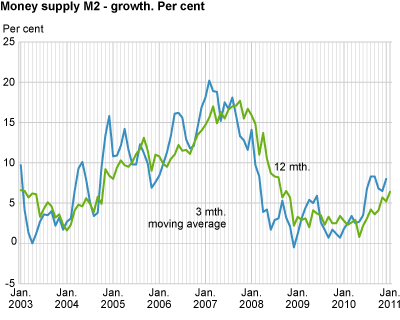Content
Published:
This is an archived release.
Sharp increase in money supply growth
The twelve-month growth in total money supply (M2) was 6.4 per cent to end-January. This is the highest twelve-month growth since October 2008, and an increase from 5.2 per cent to end-December 2010. The increased growth stemmed from enterprises.
The total money supply amounted to NOK 1 638 billion by end-January, up from NOK 1 611 billion by end-December.
Sharp increase in enterprises’ money supply growth
Non-financial enterprises’ money supply amounted to NOK 558 billion at end-January, up from NOK 542 billion at end-December. The twelve-month growth went up from 5.6 per cent to end-December, to a total of 8.8 per cent to end-January. This is the highest twelve-month growth in non-financial money supply growth since April 2008. Non-financial enterprises’ money supply constituted 46 per cent of their gross domestic debt measured by the credit indicator C2 at end-January.
Other financial enterprises’ money supply amounted to NOK 152 billion at end-January, up from NOK 141 billion at end-December. The twelve-month growth was 3.4 per cent to end-January, up from -1.5 per cent to the previous month.
Decrease in households’ money supply growth
Households’ money supply amounted to NOK 870 billion by end-January, up from NOK 864 billion the previous month. This constituted more than half of the total money supply. The twelve-month growth in households’ money supply was 5.0 per cent to end-January, down from 5.5 per cent to end-December. The growth in households’ money supply was lower than the growth in households’ gross domestic debt, which was 6.5 per cent to end-January, according to the credit indicator C2 . For more information on the financial position of households, see the financial accounts in the national accounts .
Municipal government’s money supply growth unaltered
Municipal government’s money supply amounted to a modest NOK 58 billion at end-January, down from NOK 63 billion at end-December. The twelve-month growth was at the same time 14.7 per cent, unaltered from the previous month.
| August 2010 | September 2010 | October 2010 | November 2010 | December 2010 | January 2011 | ||||||||||||||||||||||||||||||||||||||||||||||||||||||||||||||||||||||||||
|---|---|---|---|---|---|---|---|---|---|---|---|---|---|---|---|---|---|---|---|---|---|---|---|---|---|---|---|---|---|---|---|---|---|---|---|---|---|---|---|---|---|---|---|---|---|---|---|---|---|---|---|---|---|---|---|---|---|---|---|---|---|---|---|---|---|---|---|---|---|---|---|---|---|---|---|---|---|---|---|
| M0 - 12 mth. | -5.7 | 1.0 | -26.6 | 11.9 | -0.6 | 8.4 | |||||||||||||||||||||||||||||||||||||||||||||||||||||||||||||||||||||||||
| M1 - 12 mth. | 2.2 | 2.0 | 2.4 | 5.0 | 6.0 | 6.1 | |||||||||||||||||||||||||||||||||||||||||||||||||||||||||||||||||||||||||
| M2 - 12 mth. | 4.2 | 3.6 | 4.1 | 5.7 | 5.2 | 6.4 | |||||||||||||||||||||||||||||||||||||||||||||||||||||||||||||||||||||||||
| M2 - 3 mth. moving average | 8.3 | 8.3 | 6.8 | 6.5 | 8.0 | ||||||||||||||||||||||||||||||||||||||||||||||||||||||||||||||||||||||||||
| M2 households - 12 mth. | 4.1 | 4.6 | 5.1 | 5.4 | 5.5 | 5.0 | |||||||||||||||||||||||||||||||||||||||||||||||||||||||||||||||||||||||||
| M2 non-financial enterprises - 12 mth. | 1.1 | 0.8 | 1.4 | 5.4 | 5.6 | 8.8 | |||||||||||||||||||||||||||||||||||||||||||||||||||||||||||||||||||||||||
Sharp increase in base money growth
Base money amounted to NOK 99 billion at end-January, down from NOK 134 billion the previous month. The decrease is mainly caused by a decrease of bank deposits in Norges Bank during January, but notes and coins in circulation also contributed to the decrease. Despite the decrease in actual level, the twelve-month growth in M0 increased from -0.6 per cent to 8.4 per cent during January. This increase in growth is caused by a larger decrease in January last year than in January this year (basis effect).
|
The money supply (broad monetary aggregate) M2 consists of notes and coins, unrestricted bank deposits, certificates of deposit and units in money market funds owned by the money-holding sector, i.e. households, non-financial enterprises, municipalities and financial enterprises other than state lending institutions, banks and money market funds.
The base money (M0) is defined as banks’ and the money-holding sector's notes and coins and deposits in Norges Bank. Banks’ deposits in Norges Bank comprise current account (sight) deposits and fixed rate (time) deposits (F-deposits), from Norges Bank’s monthly balance sheet.
Other financial enterprises include financial enterprises other than lending institutions, banks and money market funds. |
|
Growth based on the three-month moving average is defined as growth in average money supply (seasonally-adjusted figures) in the latest three-month period in relation to the previous three-month period. The growth is adjusted for exchange rate valuation changes and statistical breaks as an annualised figure. The calculation is centred; in other words, the observation is set at the middle month of the latest three-month period. |
Tables
The statistics is published with Monetary aggregates.
Contact
-
Statistics Norway's Information Centre
E-mail: informasjon@ssb.no
tel.: (+47) 21 09 46 42

